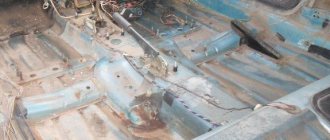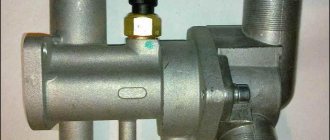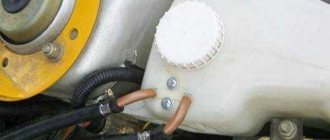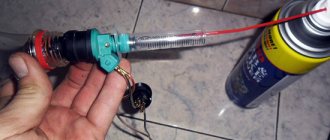The thermostat is one of the most important components of the VAZ-2110 engine cooling system.
It is he who regulates the direction of antifreeze flows in the system, which can move in a large or small circle. Failure of the thermostat can lead to overheating of the motor, which may even jam. At best, the engine simply will not reach operating temperature.
In order to keep the engine from overheating, you need to know all the ways to check the functionality of the thermostat, which can be used without removing the device from the car.
Methods for checking the health of the thermostat
If the driver detects one of the above malfunctions, he will have to check the serviceability of the thermostat. At the same time, there are two ways to check this device: with removal from the car and without removal. Let's talk about each method in more detail.
Checking the device without removing it from the car
This is the simplest option that every car enthusiast can handle. The main thing is that the engine is completely cold before starting the test.
The engine starts and idles for 20 minutes
During this time, the antifreeze will heat up properly, but it will not yet enter the radiator. After 20 minutes, carefully touch the upper thermostat tube with your hand. If it is cold, it means that the antifreeze circulates in a small circle (that is, it enters only the engine cooling jacket and the small stove radiator)
That is, the thermostat valve is still closed, and in the first 20 minutes of operation of a cold engine this is normal.
If the upper tube is so hot that it is impossible to touch it, then the valve is most likely jammed. Or it has lost its tightness and stopped responding adequately to temperature changes.
If the upper thermostat tube heats up, but it does so very slowly, this indicates that the central valve is not fully opening. Most likely, it is stuck in the half-open position, which in the future will lead to difficult starting and a very long warm-up of the engine.
Checking the device by removing it from the car
Sometimes it is not possible to check the serviceability of the thermostat using the above method. Then there is only one way out: remove the device and check it separately.
- First you need to wait until the car engine has completely cooled down. After this, all the antifreeze is drained from the car (it is best to drain it into a small basin, having first completely unscrewed the cap from the expansion tank).
- The thermostat is supported by three pipes, which are attached to it using steel clamps. These clamps are loosened with a regular flat-head screwdriver and the pipes are removed manually. After this, the thermostat is removed from the engine compartment of the “Seven”.
- The thermostat removed from the car is placed in a pan of water. A thermometer is also placed there. The pan is placed on the gas stove. The water gradually warms up.
- All this time you need to monitor the thermometer readings. When the water temperature reaches 90°C, the thermostat valve should open with a characteristic click. If this does not happen, the device is faulty and needs to be replaced (thermostats cannot be repaired).
The first way to check the serviceability of the VAZ-2115 thermostat
To make sure that the thermostat element of the vehicle's cooling system is in good or bad condition, you will need to perform the following steps:
- Start the car engine.
- Warm up the car for 10 minutes.
- Open the hood lid.
- Check by touch the radiator pipes - upper and lower:
- with a working thermostat element, the hot pipes are at the same temperature;
- if the thermostat is faulty (the valve is stuck in a closed or intermediate position), the pipes will overheat because the coolant circulates in a small circle.
As you can see, such a tactile testing method will not cause difficulties even for a novice car enthusiast.
The principle of operation of the thermostat on the VAZ 2114
The constituent structure of the thermostat is a fairly simple mechanism that is suitable for distributing the movement of liquid over small and large cooling circles (this depends on the supply temperature).
Thermostat: 1 – inlet pipe (from the radiator); 2 – rubber insert; 3 - solid heat-sensitive filler; 4 – bypass valve spring; 5 – inlet pipe (from the engine); 6 – bypass valve; 7 - outlet pipe (to the pump); 8 - main valve spring; 9 - main valve; 10 – pipe (from the expansion tank); 11 – piston.
A simple standard class 2114 thermostat, which is installed directly at the factory, consists of the following types of spare parts:
Thermostat device
- frame;
- bypass valve spring;
- bypass valve;
- main valve spring;
- main valve;
- pipes;
- piston with holder;
- temperature sensitive element.
Thermostat operating principle
- The temperature-sensitive element gives a signal to start the operation of this thermostat.
- If the main valve is closed, then after the motor starts running, the liquid in the system heats up and begins to move in a smaller circle.
- The liquid passes through the thermostat device and heats the sensitive element (it promotes expansion, thereby causing pressure on the valve).
- When the coolant is heated to the desired point (87 degrees), the valve begins to open little by little, and the coolant is gradually placed in a larger circle.
- If the heating of the coolant reaches 102 degrees, the valve will open completely and the fluid will circulate through the radiator.
- Consequently, after the machine’s engine stops operating, the liquid will begin to cool, and the temperature-sensitive element will compress and the valve will return to its initial position due to the return spring.
- It may happen that due to wear or damage (in extreme cases, factory defects), the VAZ 2114 thermostat becomes stuck in some position.
- Accordingly, the car engine may take a very long time to warm up, or, on the contrary, the engine overheats, which is a dangerous sign.
- Overheating of the motor can lead to massive damage, even self-destruction of the engine. In this case, major repairs will have to be carried out.
Price
The cost of a thermostat depends on whether it is purchased assembled or a separate thermoelement, as well as on the manufacturer, store and region of purchase. The table below shows the average cost of thermostats for the VAZ 2110.
Injection internal combustion engine
| Parameter | Price | vendor code |
| Assembled | From 1500 rubles | 21082-1306010-83 |
| Lid with thermocouple | From 800 rubles | 210821306020 |
| Thermocouple | From 400 rubles | 21082-1306100 |
Carburetor internal combustion engine
| Parameter | Price | vendor code |
| Assembled | From 500 rubles | 2110-1306010 |
Ways to check an element
You can check the operation of the thermostat yourself directly in the car. In the vast majority of cases, such diagnostics give reliable results. You need to start checking when the engine has completely cooled down: start it and periodically feel the lower part of the radiator and the pipe extending from the bottom back to the engine.
The serviceability of the thermostat is determined by the following signs:
- at the initial stage of warming up, the radiator and the pipes suitable for it are completely cold;
- at an antifreeze temperature of 40–60 °C, the upper supply hose begins to warm up, the lower one remains cold;
- when the antifreeze heats up to 90–95 °C, the entire area of the heat exchanger and the lower pipe become hot, which indicates the opening of the damper and the movement of liquid along a large circuit.
It is recommended to carry out diagnostics until the sensor is triggered and the fan automatically turns on.
Deviations from the norm are interpreted as follows:
- If the inlet and outlet pipes together with the radiator immediately warm up, the thermostat is stuck in the open position. Antifreeze initially flows in a large circle, hence the heating.
- When the temperature reaches 90 °C, the bottom of the heat exchanger and the outgoing hose remain cold - the thermoelement damper is tightly closed, the part has become unusable.
- When the top of the radiator is hot and the bottom is slightly warm, the thermostat is stuck half-closed.
Unlike the first two points, the last conclusion requires mandatory confirmation. It is quite difficult to make a clear diagnosis when the coolant is divided into two streams moving along different circuits. Uneven heating of the heat exchanger fins, turning on of the fan and temperature surges are indirect signs. Symptoms of an air lock in the cooling system appear similarly.
To clearly check the functionality of the thermostat, it will have to be removed from the car. Disassembly and diagnostics are performed in the following order:
- Let the engine cool and drain the antifreeze - first from the cylinder block, then from the radiator. It is more convenient to empty the system into a wide container with low sides.
- Loosen the clamps securing the pipes to the thermostat. Disable them and remove the element.
- Inspect the part for a slightly open damper. If a malfunction is detected, further checking is pointless - you need to buy and install a new spare part.
- Heat a pan of water on the stove. When its temperature approaches boiling, lower the thermostat into the container and watch the damper. It should open without delay.
- Remove the part from the pan. When cooled, the thermoelement should immediately close the passage.
If during the inspection it turns out that the damper does not work or is jammed, the part must be replaced, since it cannot be repaired. Considering the large number of fakes on the auto parts market, you can first test a new thermostat in a store. Close the outlet pipe with your finger and try to blow air through the inlet pipe. A hermetically sealed damper will prevent this from happening.
Retest the new part at home by immersing it in a pan of boiling water. If the heat-sensitive mechanism does not work, return the defective part to the store or exchange it for another one.
How to check the thermostat
To fully check the thermostat and identify absolutely any of its malfunctions, it is enough to know only three methods. Two of them allow you to carry out diagnostics without draining the coolant or disassembling anything. Let's start with them.
Checking the thermostat with bare hands
All you need to check the thermostat using this method is a working engine temperature gauge on the instrument panel. By observing its behavior, you can promptly identify almost all of the malfunctions described above. Naturally, you cannot do without understanding how the cooling system in general, and the thermostat in particular, works.
The algorithm is like this:
- While the engine is warming up, the temperature does not rise for a long time - the thermostat is either not completely closed, or it is completely stuck open.
- The temperature almost never reaches normal - the thermostat either opens early or is always open.
- The arrow goes off scale - it is obvious that the thermostat is not working. It is either stuck closed or is starting to close too early.
The disadvantage of this method is, of course, the low diagnostic accuracy. In particular, you need to remember that the temperature going through the roof does not always indicate a broken thermostat. The engine may overheat for other reasons. For example, the main radiator is dirty, the fan is not working, the coolant level is low, or there is air in the system.
Checking the thermostat with thermometers
Second way. Its use allows you to check the thermostat with high accuracy without removing it from the car. As the name suggests, you will need thermometers. And those that can be attached to the car’s cooling system. In addition, the measuring range of the instruments must be at least up to +150°C. The most convenient tool for these purposes is a multimeter with a thermocouple and a corresponding function. A kitchen thermometer, if available, will also work.
The algorithm for checking the thermostat with thermometers is as follows:
- Initially, the engine should be cold.
- The first thermocouple is attached to the branch pipe of the small circuit of the cooling system closer to the thermostat. Be sure to ensure that the surrounding air does not introduce errors. Therefore, you should wrap the thermocouple with electrical tape.
- The second one is wound on the other side. That is, between the thermostat and the main radiator. Closer to the first one.
- We start the engine and watch the temperatures before and after the thermostat.
- We draw appropriate conclusions about its performance based on the information presented above.
Here is an example for clarity. Let's say you are warming up a cold engine, and the temperature goes up on two devices at once. This clearly indicates that the thermostat is stuck open. If it is working properly, then the small circuit should warm up, and the large circuit should remain almost cold until the motor reaches operating temperature. When it is reached, the temperature in the large circuit should begin to rise, and in the small circuit it should fluctuate back and forth.
Checking the thermostat in boiling water
A folk method, one might say. Simple, clear and accurate. The only drawback is that the thermostat must be removed from the car to check. In addition, you will need a container of water, a stove and a thermometer to measure the temperature of liquids. As a matter of fact, if the thermostat is stuck in some position, then you will understand it immediately after disassembly. That is, there will be no need to check anything in boiling water. If visually everything looks functional, we proceed to the test.
The algorithm is like this:
- Secure the thermostat in a container of water so that it is completely immersed in it, but does not touch the walls or bottom.
- Similarly, install a thermometer in the water.
- Heat the water until the thermostat begins to open slightly.
- Record the water temperature.
- Heat until boiling.
- Note the temperature at which the thermostat opened fully.
- Check the resulting numbers either with the inscriptions on the thermostat itself or with the instruction manual for your car.
It is clear that this method allows you to accurately identify all thermostat malfunctions, including late or early operation.
Diagnosis at home
To check, place the thermostat in a container, then fill its body with boiling water. If the device is working properly, the valve should begin to open almost immediately. When the water temperature drops, the return spring will return the valve to its original position.
To most accurately test the thermostat, place a container with the thermostat immersed in water on the heater. Using a thermometer, check at what temperature the valve begins to open. The operating temperature range of the thermostat can be found in the repair and operating manual for your car. Manufacturers often indicate this information directly on the thermostat housing.
Resource
A mechanical thermostat is an extremely reliable car part with virtually nothing to wear out. It fails only due to natural wear and tear of the rubbing parts of the valve stem and guide. It is extremely difficult to predict the mileage of a car that will require replacement, but often this happens no earlier than 150-200 thousand km.
Electronically controlled thermostats fail much more often. In this case, the malfunction may be either in the heating element or in the control circuit from the electronic engine control unit (ECU).
Using low-quality coolant and driving on water significantly accelerates mechanical wear. Corrosion, deposits, and scale slow down the valve's performance and can cause jamming in the open/closed position.
Electronic thermostat
The design of the electronically controlled cooling system on Volkswagen, Skoda, and Audi vehicles requires the presence of a heater built into the thermostat valve sensing element. At certain engine operating conditions, the heater is used to accelerate the opening of the thermostat.
The self-diagnosis system is capable in many cases of determining the nature of the malfunction and displaying it in an error code. Using diagnostic equipment, you can check the functionality of the system without removing the thermostat from the car. By reading the fault code after the “Check Engine” appears on the dashboard, you can see:
- open circuit;
- short circuit to ground;
- Short circuit to +.
You can indirectly check the performance of the heating element by measuring its resistance. Usually this value is within 12-15 Ohms, but before checking it is better to clarify the normal resistance of a specific model of electronic thermostat.
If you know how to use a multimeter, you can test your heater at home. Infinite resistance will indicate a break in the heater. Also, in the resistance measurement mode, you can check the integrity of the control circuit wires. The ECU controls the heater using a PWM signal, so you won’t be able to check the signal at home without an oscilloscope.
Types of VAZ thermostats and which one is better
Visually, even an experienced salesman cannot distinguish a kopek thermostat from a Niv one. Because the difference is inside them and in the location of the pipes. All Togliatti thermostats are made according to the ancient Fiat design - they are removed from the cylinder head into a separate unit and fixed to the pipes and hoses of the cooling system. Here are the main types of VAZ thermostats:
All classic Zhigulis had a 2101 thermostat under the hood, which can be identified by the location of the pipes; they are turned opposite each other almost at a right angle
However, the most important difference is that the thermal operating mode of rear-wheel drive Zhiguli engines required blocking the valve at 80 degrees and fully opening it at an antifreeze temperature of 95 degrees
Exactly the same device was and is being installed on the Niva. The only difference is that the angle between the pipes tends to 180 degrees.
Thermostat VAZ 21213, 21214 (Niva)
The eight thermostat is installed on all carburetor Samaras in their countless modifications. The difference with classic motors in terms of thermoregulation is that in thermostat 2108 the valve should operate seven degrees later. This happened due to the more advanced design of the combustion chamber, so until the antifreeze temperature reaches 87 degrees, the valve should be closed, and only at 102 degrees should it open.
Modern thermostats on the spare parts market are not distinguished by high accuracy and high quality workmanship, so after a series of tests the plant gave two degrees to the manufacturers. As a result, on boxes with thermostats for the entire Samara family, you can often see the number 85. Visually, the 2108 thermostat is distinguished by the presence of a thin pipe to remove possible air bubbles.
The tenth VAZ family received exactly the same thermostat housing as on the classic, but in a mirror image. It does not have a small pipe for air outlet, since the design for the carburetor tens provided a separate tee, which greatly complicated the decoupling of the hoses under the hood. By the way, the figure-eight device is also perfect for carburetor tens; the only thing you need to do is tightly plug the small air hole.
Such thermostats have become the most popular, so when purchasing them, you should definitely look inside; there should be a curtain made of plastic or metal, which better redistributes the flow of liquid to the thermoelement. If it is not there, the valve response temperature can differ greatly (up to 10-15 degrees) from the nominal value, which leads to engine overheating.
Purpose and design of the VAZ-2107 thermostat
In the engine cooling system, the thermostat is installed at the intersection of the pipes from the engine and radiator to the pump. After starting the engine when cold, the thermostat is closed - it blocks the passage from the radiator when it is completely open from the engine. The coolant circulates in a small circle through the cylinder block and pump, which ensures quick warm-up of the engine. When the antifreeze temperature reaches values close to the operating temperature (for a VAZ-2107 with a carburetor 80.6–81.5 °C), the main thermostat valve begins to open, freeing the passage of the pipe from the radiator, and at the same time the bypass valve begins to block the flow of antifreeze from the engine. The pump also begins to “drive” the antifreeze in a large circle: cylinder block, radiator, thermostat, pump. When the antifreeze temperature reaches operating values (for VAZ-2107 94 °C), the thermostat opens completely:
- the pipe from the engine is completely blocked;
- from the radiator is completely open.
Antifreeze circulates only in a large circle. When cooling the antifreeze, the reverse process occurs.
The VAZ-2107 temperature regulator, regardless of the engine type (with injector or carburetor), has the following design:
- non-separable cylindrical body with three pipes;
- directly the thermostat itself.
Narrowing of the bypass channel
If you decide that it is the bypass channel on the VAZ 2110 that needs to be adjusted, then the 6-hole thermostat should not have any problems. But with a 5-hole one, malfunctions may occur due to the fact that the cold pipe of the stove (outlet) will not be washed. Therefore, think about whether you need such a modification; maybe it’s better to immediately install a Granta thermostat or a six-hole one.
To reduce the bypass, you need to do the following:
- Cut a plate out of sheet aluminum so that it fits exactly inside the vehicle;
- Secure the plate with a rivet or cold welding, but so that the fastening does not interfere with the flow of coolant in a small circle;
- In this plate you need to drill a new hole of 5 or 6 mm (instead of the standard 8 mm);
- In addition to the steps described above, on a 6-hole heater, the stove return is connected to a thermostat.
After this modification, you will notice that the interior will warm up better and faster, but engine warming up will slow down somewhat.
Important points
When replacing a thermostat, there are a couple of important nuances that cannot be ignored. Here they are:
- on the latest models of “sevens” (cars 2010 and older), the clamps on the thermostat are not worm-type, but band-type. This means that you won’t be able to remove them with a regular flat-head screwdriver, and to remove them you will have to use a special clamp wrench, which not every car owner has in their garage. If the car owner is the “happy” owner of a thermostat with band clamps, then there is only one way out: go to the store for a tool. A clamp wrench costs about 300 rubles;
- Even after draining the antifreeze from the system, personal protective equipment must not be neglected. Please remember: you cannot completely drain the coolant from the machine. Some part of this liquid will still remain in the thermostat pipes and in the thermostat itself. Taking into account the fact that many car enthusiasts prefer to remove thermostats from below, without leaving the inspection hole, antifreeze can easily get into the driver’s eyes. This, in turn, can lead to serious eye irritation and even blindness. Therefore, you should only change the thermostat while wearing safety glasses and gloves.
So, changing the thermostat on the “seven” is not a difficult task. Preparatory procedures take much more time: cooling the engine and completely draining the antifreeze from the system. Nevertheless, even a novice car owner can cope with these procedures. The main thing is to take your time and strictly follow the recommendations given above.
How to check a car's thermostat
There are two main ways to check a car's thermostat. One of them is carried out without removing the part, but requires a pyrometer, and the second is simpler, but the element will need to be removed from the engine during the test.
Checking the thermostat without removing it from the engine
As you know, the thermostat housing is connected to the upper radiator hose, which is included in a large circle of coolant circulation. Accordingly, with the thermostat working, after starting the engine, the upper radiator hose should remain cold (slightly warm) for some time until antifreeze is released through it.
To check the thermostat without removing it from the engine, get a pyrometer (temperature measuring device). You may come across the opinion that the check should be done without a device, measuring the temperature with your hands, but this is quite dangerous, given the large number of moving parts when the engine is running.
Point the pyrometer at the upper radiator hose and start the engine (cold start). For two or three minus periods, observe the device’s indicators. Next, draw a conclusion about the serviceability of the thermostat according to the following rules:
- The hose was cold for two or three minutes (or its temperature rose slightly), and then quickly warmed up. This indicates that the thermostat is working properly, and it switched the coolant circulation from a small circle to a large circle after the engine has sufficiently warmed up;
- The hose initially warmed up slowly. In this case, we can say that the thermostat is stuck in the open position and the antifreeze does not circulate in a small circle;
- The hose did not begin to warm up quickly after two or three minutes. That is, the thermostat is faulty and it does not switch the coolant circulation from a small circle to a large one.
Important: While checking the thermostat, monitor the engine temperature on the instrument panel. If the thermostat is stuck and does not switch the coolant to a large circle, the engine will begin to overheat, which can lead to the failure of expensive parts
Checking the thermostat in the pan
A widespread and well-known way to test the thermostat yourself is using a saucepan. As you might guess, before diagnostics you will need to remove the thermostat from the car engine and bring it home. After this, do the following:
- Take a pot and fill it with water;
- Inspect the thermostat housing and read the technical information on it, which indicates at what temperature it should switch;
- Hang the thermostat in the pan so that it is immersed in water, but does not touch the walls and bottom of the container, that is, it comes into contact only with water;
- Start heating the water and put a regular thermometer in it to measure the temperature of the liquid;
- When the water approaches the thermostat switching value from closed to open, make sure this happens. Also compare the thermometer reading, recording the temperature at which the coolant circuit switching valve opens with the ideal values indicated on the device body.
If the valve opens when heating water, track its behavior when cooling the liquid, checking at what temperature it returns to its original position. Based on the data obtained, draw a conclusion about the functionality of the thermostat.
Instruction No. 2
Experienced car enthusiasts offer another way to improve the VAZ-2110 thermostat device. This method consists of replacing a thermoelement with a low temperature regime with a higher one - from 85 degrees to 92 degrees. To do this, you need to select an analog thermostat model (for example, Wahler), from which you can remove the thermoelement and the spring.
So let's get started. The first step is to remove the spring and thermoelement from the analog thermostat, cut the body of the device and take out the necessary structural parts.
The second step is to grind the spring down to the required size, so that it fits tightly into the body of the “original” thermostat (it is best to do this on a plane, as a result of which the last coil will become flat and will fit better).
The third step is to remove the “original” thermostat from the engine; to do this, unscrew the three screws of the rear cover.
The fourth step is to take out an 85-degree thermocouple and a spring from the “native” thermostat device.
The fifth step is to replace it with analog parts (an important nuance should be taken into account: the clamping bar must remain “original”).
The sixth step is to assemble a thermostat with a new filling and install it on the internal combustion engine of the car.
Thanks to this modification method, the engine temperature will not be below 88 degrees. As a result of this modification, the vehicle owner will receive the following benefits:
- there will be no thermal overheating of the engine;
- fuel consumption will decrease (according to car enthusiasts, up to 1.5 liters);
- the engine runs more smoothly.
Thermostat VAZ 2115: Replacement, check where it is located
A thermostat is a sensor designed to maintain a certain temperature. The thermostat blocks the path of antifreeze or any other coolant into the radiator until the engine reaches a certain operating temperature. The operating temperature of the engine is considered to be 90 degrees. The thermostat opens the coolant path at 95 degrees Celsius. Thanks to the thermostat, the engine spends less time warming up to operating temperature. It follows that the thermostat saves your pennies in your pocket and protects the environment. And it is located between the radiator and the engine.
Table of contents
Replacement How to check Which one is better to put Where is it located What does it look like
Replacement
First of all, you need to check whether the thermostat is really not working. We do the following:
1. start the car and feel the lower radiator pipe, it should be cold;
2. wait until the engine warms up to a temperature of 80-85 degrees and feel the pipe again, it should become warm.
Let's move on to the process of removing the thermostat. First, drain the coolant (you can only drain it from the radiator). Now loosen the hose clamps that are attached to the thermostat and remove them.
Then we remove the thermostat from the VAZ 2115.
To check if the thermostat is working, immerse it in water and start heating it; when the water temperature reaches 83-87 degrees, you should see the valve begin to open. If the valve stays still, the thermostat is faulty.
After installing the new thermostat, be sure to refill the coolant.
How to check
It is very easy to check the operation of the thermostat without removing it from the car. It is enough to start the cooled engine and check the temperature of the radiator pipes. In normal mode, when the engine is running, for some time after starting, only the upper radiator pipe will heat up slightly, and when the threshold value is reached, the lower pipe will also heat up sharply. This is evidence of normal valve operation. If heating of both radiator pipes begins simultaneously, this indicates that it is not functioning properly; most likely, the valve is constantly open.
The constantly open thermostat valve allows you to easily reach the nearest service station or spare parts store. It is much worse if the thermostat gets stuck closed, as there is a serious risk of engine overheating. Sometimes tapping on the thermostat body helps for a short time, but if the valve cannot budge, it should be removed or bent with a screwdriver. The thermostat must be replaced in the nearest locality.
Which one is better to put
It will also fit with 099 and 09, and with 083 and 093. It’s not a matter of VAZ models, the fact that components from one model fit another is a normal phenomenon for many manufacturers.
You need to buy a thermostat based on only a few things.
This is the metal from which the thermostat is made; preference should be given to stainless steel,
or brass and the second criterion is not to take Chinese spare parts under any circumstances, even if they are given away for free.
There is no option to check the thermostat while standing at the counter.
Many citizens begin to put pressure on the valve for some reason, apparently they want to check how the “spring” works, but there is no spring there, there is a special spiral made of a special material that operates only at a certain temperature.
If the seller has hot water, then lower the thermostat into the water and check the smooth movement of the rod.
Although, to be honest, it’s unlikely that the seller needs this.
Conclusion: pay attention to the metal first. Secondly to the country of manufacture, VAZ 2115 is a Russian car
Where is
It is located under the air filter housing on injection cars, but on carburetor Samara 2 (namely, the first VAZ 2115 were produced for a couple of years in a carburetor version), it is located exactly there, but the housing on them has simply been moved to a slightly different place, so it is no longer necessary on the carburetor It doesn’t take much trouble to remove the housing, but I just threw off the high-voltage wires and started working, but it doesn’t take long to remove the housing and on the injector it 100% needs to be removed to get to the thermostat, and after the housing is put aside, you will immediately see the thermostat is not armed it will even be visible to the eye (For clarity, it is indicated in the photo below with a red arrow) and next to it there is also a battery (indicated by a blue arrow) so that you understand 100% where it is and do not lose sight of it.
What should the engine operating temperature be?
Engine operating temperature shown on the instrument panel
If we take the information from the international convention of automobile manufacturers dated December 1, 1992, then the uniform standard for engine operating temperature is considered to be 90 degrees Celsius. With such indicators, the engine operates as efficiently as possible and does not create residual negative effects.
When switching to more advanced engine manufacturing technologies in 2004, it was accepted that a specific indicator of this indicator cannot be held in one position, and therefore they made a gradation of acceptable standards, which amounted to 85-105 degrees Celsius.
Engine overheating shown on the instrument panel
According to data from the manufacturer AvtoVAZ, on a 16-valve VAZ-2112 engine, the operating temperature of the engine is considered to be 87-103 degrees Celsius.
At this temperature, all systems function normally, and the motor is not subject to negative factors and consequences.
Cooling system design
The engine cooling system has many components that are interconnected, and if one fails, the entire system will not be able to function. So, let's look at the location diagram and decoding of the indicators for the cooling system of a 16-valve engine.
Diagram of the cooling system operation
1 – heater radiator; 2 – steam removal hose of the heater radiator; 3 – outlet hose; 4 – supply hose; 5 – coolant temperature sensor (in the block head); 6 – pump supply pipe hose; 7 – thermostat; 8 – filling hose; 9 – expansion tank plug; 10 – coolant level indicator sensor; 11 – expansion tank; 12 – exhaust pipe; 13 – liquid chamber of the carburetor starting device; 14 – radiator outlet hose; 15 – radiator supply hose; 16 – radiator steam outlet hose; 17 – left radiator tank; 18 – sensor for turning on the electric fan; 19 – fan electric motor; 20 – electric fan impeller; 21 – right radiator tank; 22 – drain plug; 23 – electric fan casing; 24 – timing belt; 25 – coolant pump impeller; 26 – supply pipe of the coolant pump; 27 – coolant supply hose to the throttle pipe; 28 – coolant drain hose from the throttle pipe; 29 – coolant temperature sensor in the outlet pipe; 30 – radiator tubes; 31 – radiator core.
Main malfunctions and ways to solve them
In fact, there are quite a lot of components in the cooling system that are susceptible to failure. This depends not only on the service life, but also on maintenance, as well as the quality of the parts. So, let's look at the main components, faults and methods for solving them.
Cooling radiator
Cooling radiator pulled from the engine
As practice shows, this part lasts quite a long time. The main cause of failure is clogged internal channels. So, if the blockage is sufficiently dense, the engine begins to heat up, the high pressure created by the pump can lead to a rupture of the tube and the radiator will leak.
Some car enthusiasts have it soldered and cleaned, but as practice shows, after a short period of time, a leak forms again. Therefore, if this part fails, it must be replaced with a new one.
Heater radiator
Heater radiator assembly with fan
Pipes
KIT kit of cooling system pipes
One of the main components of the cooling system, since it is through the pipes that the fluid circulates through the system.
The main malfunction is considered to be wear, namely the appearance of cracks and leaks of coolant. To fix the problem, you need to replace the damaged element.
Of course, it is recommended to change everything in sets, since it is unknown how many kilometers later another one will have to be replaced, and the process itself requires draining the coolant.
Water pump
Water pump removed from the car
The pump circulates coolant throughout the system. So, if a leak occurs from the water pump bearing or noise increases, these are the first signs that the part needs to be replaced.
Thermostat
Thermostat disassembly process
The thermostat is the part of the cooling system that is most often replaced.
Thus, the first signs of a unit malfunction are considered to be an increase in the operating temperature of the engine to the maximum, as well as frequent turning on of the cooling fan. To fix the problem, you need to replace it with a new product.
Radiator cooling fan
Electric fan with casing removed
This part provides cooling of the liquid, but if there is insufficient oncoming wind flow, it is this part that additionally creates an air flow. The cooling fan prevents the temperature from rising to a critical level.
It turns on at 100 degrees Celsius, and turns off at 94.
Cooling system sensor
Cooling sensor location
Part of the engine management system that sends a pulse to the ECU to turn the cooling fan on or off and also reports the status and changes in engine operating temperature. If it fails, the part must be replaced to eliminate the malfunction.
How to replace the thermostat on a VAZ-2109 with an 8 or 16 valve engine?
This operation should not cause difficulties, and any car owner should be able to handle it, regardless of his experience in the field of car repair. What actions need to be performed are described in this article. The thermostat is a mechanical unit; its operation is based on physical rules. Inside it is wax, which is sensitive to temperature changes. When the coolant is heated, the wax melts and a damper opens, allowing coolant to enter the system, where it is cooled.
Thermostat design VAZ 2109: 1 – inlet pipe from the radiator, 2 – rubber insert, 3 – solid heat-sensitive filler, 4 – bypass valve spring, 5 – inlet pipe from the engine, 6 – bypass valve, 7 – outlet pipe to the pump, 8 – main valve spring, 9 – main valve, 10 – pipe from the expansion tank, 11 – piston.
From the VAZ-2109 to the modern Granta model, thermostats perform their function adhering to one principle, and they are interchangeable with each other. The new unit is smaller in size than the old VAZ models; this fact will not interfere with installing the part from the old VAZ model.
To make the stove heat better, a thermostat from the new VAZ model is installed for this purpose.
Narrowing of the bypass channel
If you decide that it is the bypass channel on the VAZ 2110 that needs to be adjusted, then the 6-hole thermostat should not have any problems. But with a 5-hole one, malfunctions may occur due to the fact that the cold pipe of the stove (outlet) will not be washed. Therefore, think about whether you need such a modification; maybe it’s better to immediately install a Granta thermostat or a six-hole one.
To reduce the bypass, you need to do the following:
- Cut a plate out of sheet aluminum so that it fits exactly inside the vehicle;
- Secure the plate with a rivet or cold welding, but so that the fastening does not interfere with the flow of coolant in a small circle;
- In this plate you need to drill a new hole of 5 or 6 mm (instead of the standard 8 mm);
- In addition to the steps described above, on a 6-hole heater, the stove return is connected to a thermostat.
After this modification, you will notice that the interior will warm up better and faster, but engine warming up will slow down somewhat.
Clutch slipping after replacing all its parts
After replacing all elements, adjustment is required, but many car owners ignore this point. The cause is slipping, the car accelerates slowly, the engine speed does not correspond to the speed of the car. The engine just roars, and the car is driving quite slowly, as they say, slipping.
In cars with a mechanical clutch cable, adjustment is made by the cable itself. In hydraulically driven machines, this process is carried out using a clutch rod. In modern cars, you often come across rods that do not have adjustments. But this does not mean at all that it cannot be produced. In such cases, adjustment of the clutch pedal itself is provided, but not everyone knows about this possibility. » alt=»»>
How to replace a thermostat on a Priora
In order for the Lada Priora 16 valves, and any other car model, to work properly and not let the driver down on the road, the car owner must monitor the technical serviceability of the car and promptly repair any breakdowns. If during the next check an antifreeze leak is detected, then you need to first check the thermostat, which will most likely have to be removed and replaced. Replacing a thermostat on a Priora is not a difficult task, so every car owner can cope with such a task, if, of course, this process is carried out according to the instructions provided by professionals in their field.
Thermal service thermostat
The manual thermostat is installed directly on the radiator and significantly saves heat.
Signs of thermostat malfunction often include accumulated sediment in the refrigeration system. Scale appears on the heat-sensitive element after it has lost its rustiness, and it begins to react incorrectly to temperature changes in the cooling medium, or even stops responding altogether.
Possible reasons for this breakdown: leakage of water from the cooling unit, untimely replacement of the cooling unit, possible jamming of the thermostat in the open position, in which the cooling unit will constantly circulate along the large circuit. The other reason is that the engine has to warm up for a long time to the temperature of the engine, which is often simply beyond its reach. And when the thermostat is stuck in the closed position, the circulation will only be small, which will inevitably lead to overheating of the engine.
Replacing the thermostat on a VAZ 2114
How will the replacement of the thermostat on a VAZ 2114 proceed?
It is performed in this order:
- Install the car on a special platform, remove the air filter from under the hood.
- We take out the expansion tank and drain all the liquid present.
- Loosen the cooling system hoses and remove them.
- The nuts that hold the thermostat housing are unscrewed.
- We remove the old thermostat, and if dismantling is difficult, you need to rock it.
- Remove traces of sealant from the specially designated area for the old thermostat and fill in new sealant, placing a gasket on top.
- Next, install the new thermostat and secure its position with nuts.
- We apply a layer of sealant to the pipes of the device, put on the hoses and secure them with clamps.
- After 2 hours, pour new coolant into the system.
- Now we start the engine and monitor the temperature readings to make sure whether the device is working properly or if something needs to be fixed.
Possible faults
The thermostat is a fairly simple and reliable part, but it has its own service life. The main malfunctions of the thermostat on the VAZ-2112 include:
- Valve jamming in seat. Occurs due to exposure to scale or contamination. This problem often occurs in cars whose engines have not been started for a long time.
- Incomplete valve closure. Occurs due to loss of elasticity of the return spring or dirt getting under the valve seat.
A faulty unit causes the following malfunctions:
- The engine overheats at idle speed. The reason for the valve being stuck in the seat. Even when driving at high speed, the fluid does not cool.
- The engine takes a very long time to heat up. The reason is the lack of contact between the valve and the seat. Some of the antifreeze gets into the engine.
Any of these faults requires a timely check of the part for serviceability.











